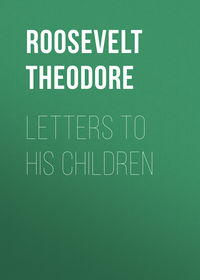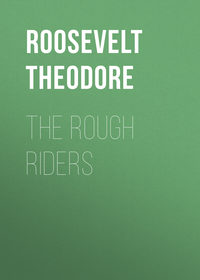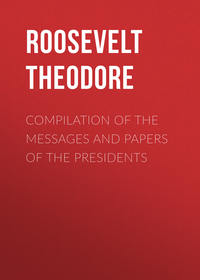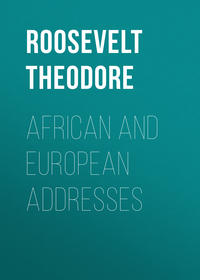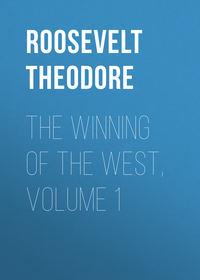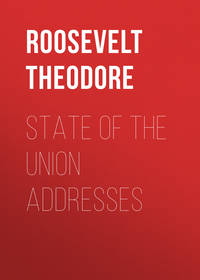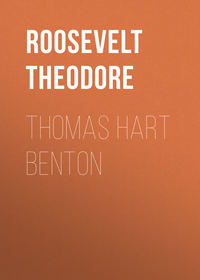 полная версия
полная версияThrough the Brazilian Wilderness
The water-birds were always a delight. We shot merely the two or three specimens the naturalists needed for the museum. I killed a wood-ibis on the wing with the handy little Springfield, and then lost all the credit I had thus gained by a series of inexcusable misses, at long range, before I finally killed a jabiru. Kermit shot a jabiru with the Luger automatic. The great, splendid birds, standing about as tall as a man, show fight when wounded, and advance against their assailants, clattering their formidable bills. One day we found the nest of a jabiru in a mighty fig-tree, on the edge of a patch of jungle. It was a big platform of sticks, placed on a horizontal branch. There were four half-grown young standing on it. We passed it in the morning, when both parents were also perched alongside; the sky was then overcast, and it was not possible to photograph it with the small camera. In the early afternoon when we again passed it the sun was out, and we tried to get photographs. Only one parent bird was present at this time. It showed no fear. I noticed that, as it stood on a branch near the nest, its bill was slightly open. It was very hot, and I suppose it had opened its bill just as a hen opens her bill in hot weather. As we rode away the old bird and the four young birds were standing motionless, and with gliding flight the other old bird was returning to the nest. It is hard to give an adequate idea of the wealth of bird life in these marshes. A naturalist could with the utmost advantage spend six months on such a branch as that we visited. He would have to do some collecting, but only a little. Exhaustive observation in the field is what is now most needed. Most of this wonderful and harmless bird life should be protected by law; and the mammals should receive reasonable protection. The books now most needed are those dealing with the life-histories of wild creatures.
Near the ranch-house, walking familiarly among the cattle, we saw the big, deep-billed Ani blackbirds. They feed on the insects disturbed by the hoofs of the cattle, and often cling to them and pick off the ticks. It was the end of the nesting season, and we did not find their curious communal nests, in which half a dozen females lay their eggs indiscriminately. The common ibises in the ponds near by—which usually went in pairs, instead of in flocks like the wood ibis—were very tame, and so were the night herons and all the small herons. In flying, the ibises and storks stretch the neck straight in front of them. The jabiru—a splendid bird on the wing—also stretches his neck out in front, but there appears to be a slight downward curve at the base of the neck, which may be due merely to the craw. The big slender herons, on the contrary, bend the long neck back in a beautiful curve, so that the head is nearly between the shoulders. One day I saw what I at first thought was a small yellow-bellied kingfisher hovering over a pond, and finally plunging down to the surface of the water after a school of tiny young fish; but it proved to be a bien-te-vì king-bird. Curved-bill wood-hewers, birds the size and somewhat the coloration of veeries, but with long, slender sickle-bills, were common in the little garden back of the house; their habits were those of creepers, and they scrambled with agility up, along, and under the trunks and branches, and along the posts and rails of the fence, thrusting the bill into crevices for insects. The oven-birds, which had the carriage and somewhat the look of wood-thrushes, I am sure would prove delightful friends on a close acquaintance; they are very individual, not only in the extraordinary domed mud nests they build, but in all their ways, in their bright alertness; their interest in and curiosity about whatever goes on, their rather jerky quickness of movement, and their loud and varied calls. With a little encouragement they become tame and familiar. The parakeets were too noisy, but otherwise were most attractive little birds, as they flew to and fro and scrambled about in the top of the palm behind the house. There was one showy kind of king-bird or tyrant flycatcher, lustrous black with a white head.
One afternoon several score cattle were driven into a big square corral near the house, in order to brand the calves and a number of unbranded yearlings and two-year-olds. A special element of excitement was added by the presence of a dozen big bulls which were to be turned into draught-oxen. The agility, nerve, and prowess of the ranch workmen, the herders or gauchos, were noteworthy. The dark-skinned men were obviously mainly of Indian and negro descent, although some of them also showed a strong strain of white blood. They wore the usual shirt, trousers, and fringed leather apron, with jim-crow hats. Their bare feet must have been literally as tough as horn; for when one of them roped a big bull he would brace himself, bending back until he was almost sitting down and digging his heels into the ground, and the galloping beast would be stopped short and whirled completely round when the rope tautened. The maddened bulls, and an occasional steer or cow, charged again and again with furious wrath; but two or three ropes would settle on the doomed beast, and down it would go; and when it was released and rose and charged once more, with greater fury than ever, the men, shouting with laughter, would leap up the sides of the heavy stockade.
We stayed at the ranch until a couple of days before Christmas. Hitherto the weather had been lovely. The night before we left there was a torrential tropic downpour. It was not unexpected, for we had been told that the rainy season was overdue. The following forenoon the baggage started, in a couple of two-wheeled ox-carts, for the landing where the steamboat awaited us. Each cart was drawn by eight oxen. The huge wheels were over seven feet high. Early in the afternoon we followed on horseback, and overtook the carts as darkness fell, just before we reached the landing on the river's bank. The last few miles, after the final reaches of higher, tree-clad ground had been passed, were across a level plain of low ground on which the water stood, sometimes only up to the ankles of a man on foot, sometimes as high as his waist. Directly in front of us, many leagues distant, rose the bold mountains that lie west of Corumba. Behind them the sun was setting and kindled the overcast heavens with lurid splendor. Then the last rose tints faded from the sky; the horses plodded wearily through the water; on every side stretched the marsh, vast, lonely, desolate in the gray of the half-light. We overtook the ox-carts. The cattle strained in the yokes; the drivers wading alongside cracked their whips and uttered strange cries; the carts rocked and swayed as the huge wheels churned through the mud and water. As the last light faded we reached the small patches of dry land at the landing, where the flat-bottomed side-wheel steamboat was moored to the bank. The tired horses and oxen were turned loose to graze. Water stood in the corrals, but the open shed was on dry ground. Under it the half-clad, wild-looking ox-drivers and horse- herders slung their hammocks; and close by they lit a fire and roasted, or scorched, slabs and legs of mutton, spitted on sticks and propped above the smouldering flame.
Next morning, with real regret, we waved good-by to our dusky attendants, as they stood on the bank, grouped around a little fire, beside the big, empty ox-carts. A dozen miles down-stream a rowboat fitted for a sprit-sail put off from the bank. The owner, a countryman from a small ranch, asked for a tow to Corumba, which we gave. He had with him in the boat his comely brown wife—who was smoking a very large cigar—their two children, a young man, and a couple of trunks and various other belongings. On Christmas eve we reached Corumba, and rejoined the other members of the expedition.
IV. THE HEADWATERS OF THE PARAGUAY
At Corumba our entire party, and all their belongings, came aboard our good little river boat, the Nyoac. Christmas Day saw us making our way steadily up-stream against the strong current, and between the green and beautiful banks of the upper Paraguay. The shallow little steamer was jammed with men, dogs, rifles, partially cured skins, boxes of provisions, ammunition, tools, and photographic supplies, bags containing tents, cots, bedding, and clothes, saddles, hammocks, and the other necessaries for a trip through the "great wilderness," the "Matto Grosso" of western Brazil.
It was a brilliantly clear day, and, although of course in that latitude and at that season the heat was intense later on, it was cool and pleasant in the early morning. We sat on the forward deck, admiring the trees on the brink of the sheer river banks, the lush, rank grass of the marshes, and the many water-birds. The two pilots, one black and one white, stood at the wheel. Colonel Rondon read Thomas a Kempis. Kermit, Cherrie, and Miller squatted outside the railing on the deck over one paddle-wheel and put the final touches on the jaguar skins. Fiala satisfied himself that the boxes and bags were in place. It was probable that hardship lay in the future; but the day was our own, and the day was pleasant. In the evening the after-deck, open all around, where we dined, was decorated with green boughs and rushes, and we drank the health of the President of the United States and of the President of Brazil.
Now and then we passed little ranches on the river's edge. This is a fertile land, pleasant to live in, and any settler who is willing to work can earn his living. There are mines; there is water-power; there is abundance of rich soil. The country will soon be opened by rail. It offers a fine field for immigration and for agricultural, mining, and business development; and it has a great future.
Cherrie and Miller had secured a little owl a month before in the Chaco, and it was travelling with them in a basket. It was a dear little bird, very tame and affectionate. It liked to be handled and petted; and when Miller, its especial protector, came into the cabin, it would make queer little noises as a signal that it wished to be taken up and perched on his hand. Cherrie and Miller had trapped many mammals. Among them was a tayra weasel, whitish above and black below, as big and blood-thirsty as a fisher-martin; and a tiny opossum no bigger than a mouse. They had taken four species of opossum, but they had not found the curious water-opossum which they had obtained on the rivers flowing into the Caribbean Sea. This opossum, which is black and white, swims in the streams like a muskrat or otter, catching fish and living in burrows which open under water. Miller and Cherrie were puzzled to know why the young throve, leading such an existence of constant immersion; one of them once found a female swimming and diving freely with four quite well-grown young in her pouch.
We saw on the banks screamers—big, crested waders of archaic type, with spurred wings, rather short bills, and no especial affinities with other modern birds. In one meadow by a pond we saw three marsh- deer, a buck and two does. They stared at us, with their thickly haired tails raised on end. These tails are black underneath, instead of white as in our whitetail deer. One of the vagaries of the ultraconcealing-colorationists has been to uphold the (incidentally quite preposterous) theory that the tail of our deer is colored white beneath so as to harmonize with the sky and thereby mislead the cougar or wolf at the critical moment when it makes its spring; but this marsh-deer shows a black instead of a white flag, and yet has just as much need of protection from its enemies, the jaguar and the cougar. In South America concealing coloration plays no more part in the lives of the adult deer, the tamandua, the tapir, the peccary, the jaguar, and the puma than it plays in Africa in the lives of such animals as the zebra, the sable antelope, the wildebeeste, the lion, and the hunting hyena.
Next day we spent ascending the Sao Lourenco. It was narrower than the Paraguay, naturally, and the swirling brown current was, if anything, more rapid. The strange tropical trees, standing densely on the banks, were matted together by long bush ropes—lianas, or vines, some very slender and very long. Sometimes we saw brilliant red or blue flowers, or masses of scarlet berries on a queer palm-like tree, or an array of great white blossoms on a much larger tree. In a lagoon bordered by the taquara bamboo a school of big otters were playing; when they came to the surface, they opened their mouths like seals, and made a loud hissing noise. The crested screamers, dark gray and as large as turkeys, perched on the very topmost branches of the tallest trees. Hyacinth macaws screamed harshly as they flew across the river. Among the trees was the guan, another peculiar bird as big as a big grouse, and with certain habits of the wood-grouse, but not akin to any northern game-bird. The windpipe of the male is very long, extending down to the end of the breast-bone, and the bird utters queer guttural screams. A dead cayman floated down-stream, with a black vulture devouring it. Capybaras stood or squatted on the banks; sometimes they stared stupidly at us; sometimes they plunged into the river at our approach. At long intervals we passed little clearings. In each stood a house of palm-logs, with a steeply pitched roof of palm thatch; and near by were patches of corn and mandioc. The dusky owner, and perhaps his family, came out on the bank to watch us as we passed. It was a hot day—the thermometer on the deck in the shade stood at nearly 100 degrees Fahrenheit. Biting flies came aboard even when we were in midstream.
Next day we were ascending the Cuyaba River. It had begun raining in the night, and the heavy downpour continued throughout the forenoon. In the morning we halted at a big cattle-ranch to get fresh milk and beef. There were various houses, sheds, and corrals near the river's edge, and fifty or sixty milch cows were gathered in one corral. Spurred plover, or lapwings, strolled familiarly among the hens. Parakeets and red-headed tanagers lit in the trees over our heads. A kind of primitive houseboat was moored at the bank. A woman was cooking breakfast over a little stove at one end. The crew were ashore. The boat was one of those which are really stores, and which travel up and down these rivers, laden with what the natives most need, and stopping wherever there is a ranch. They are the only stores which many of the country-dwellers see from year's end to year's end. They float down-stream, and up-stream are poled by their crew, or now and then get a tow from a steamer. This one had a house with a tin roof; others bear houses with thatched roofs, or with roofs made of hides. The river wound through vast marshes broken by belts of woodland.
Always the two naturalists had something of interest to tell of their past experience, suggested by some bird or beast we came across. Black and golden orioles, slightly crested, of two different species were found along the river; they nest in colonies, and often we passed such colonies, the long pendulous nests hanging from the boughs of trees directly over the water. Cherrie told us of finding such a colony built round a big wasp-nest, several feet in diameter. These wasps are venomous and irritable, and few foes would dare venture near bird's- nests that were under such formidable shelter; but the birds themselves were entirely unafraid, and obviously were not in any danger of disagreement with their dangerous protectors. We saw a dark ibis flying across the bow of the boat, uttering his deep, two- syllabled note. Miller told how on the Orinoco these ibises plunder the nests of the big river-turtles. They are very skilful in finding where the female turtle has laid her eggs, scratch them out of the sand, break the shells, and suck the contents.
It was astonishing to find so few mosquitoes on these marshes. They did not in any way compare as pests with the mosquitoes on the lower Mississippi, the New Jersey coast, the Red River of the North, or the Kootenay. Back in the forest near Corumba the naturalists had found them very bad indeed. Cherrie had spent two or three days on a mountain-top which was bare of forest; he had thought there would be few mosquitoes, but the long grass harbored them (they often swarm in long grass and bush, even where there is no water), and at night they were such a torment that as soon as the sun set he had to go to bed under his mosquito-netting. Yet on the vast marshes they were not seriously troublesome in most places. I was informed that they were not in any way a bother on the grassy uplands, the high country north of Cuyaba, which from thence stretches eastward to the coastal region. It is at any rate certain that this inland region of Brazil, including the state of Matto Grosso, which we were traversing, is a healthy region, excellently adapted to settlement; railroads will speedily penetrate it, and then it will witness an astonishing development.
On the morning of the 28th we reached the home buildings of the great Sao Joao fazenda, the ranch of Senhor Joao da Costa Marques. Our host himself, and his son, Dom Joao the younger, who was state secretary of agriculture, and the latter's charming wife, and the president of Matto Grosso, and several other ladies and gentlemen, had come down the river to greet us, from the city of Cuyaba, several hundred miles farther up-stream. As usual, we were treated with whole-hearted and generous hospitality. Some miles below the ranch-house the party met us, on a stern-wheel steamboat and a launch, both decked with many flags. The handsome white ranch-house stood only a few rods back from the river's brink, in a grassy opening dotted with those noble trees, the royal palms. Other trees, buildings of all kinds, flower-gardens, vegetable-gardens, fields, corrals, and enclosures with high white walls stood near the house. A detachment of soldiers or state police, with a band, were in front of the house, and two flagpoles, one with the Brazilian flag already hoisted. The American flag was run up on the other as I stepped ashore, while the band played the national anthems of the two countries. The house held much comfort; and the comfort was all the more appreciated because even indoors the thermometer stood at 97 degrees F. In the late afternoon heavy rain fell, and cooled the air. We were riding at the time. Around the house the birds were tame: the parrots and parakeets crowded and chattered in the tree tops; jacanas played in the wet ground just back of the garden; ibises and screamers called loudly in the swamps a little distance off.
Until we came actually in sight of this great ranch-house we had been passing through a hot, fertile, pleasant wilderness, where the few small palm-roofed houses, each in its little patch of sugar-cane, corn, and mandioc, stood very many miles apart. One of these little houses stood on an old Indian mound, exactly like the mounds which form the only hillocks along the lower Mississippi, and which are also of Indian origin. These occasional Indian mounds, made ages ago, are the highest bits of ground in the immense swamps of the upper Paraguay region. There are still Indian tribes in this neighborhood. We passed an Indian fishing village on the edge of the river, with huts, scaffoldings for drying the fish, hammocks, and rude tables. They cultivated patches of bananas and sugar-cane. Out in a shallow place in the river was a scaffolding on which the Indians stood to spear fish. The Indians were friendly, peaceable souls, for the most part dressed like the poorer classes among the Brazilians.
Next morning there was to have been a great rodeo or round-up, and we determined to have a hunt first, as there were still several kinds of beasts of the chase, notably tapirs and peccaries, of which the naturalists desired specimens. Dom Joao, our host, and his son accompanied us. Theirs is a noteworthy family. Born in Matto Grosso, in the tropics, our host had the look of a northerner and, although a grandfather, he possessed an abounding vigor and energy such as very few men of any climate or surroundings do possess. All of his sons are doing well. The son who was with us was a stalwart, powerful man, a pleasant companion, an able public servant, a finished horseman, and a skilled hunter. He carried a sharp spear, not a rifle, for in Matto Grosso it is the custom in hunting the jaguar for riflemen and spearmen to go in at him together when he turns at bay, the spearman holding him off if the first shot fails to stop him, so that another shot can be put in. Altogether, our host and his son reminded one of the best type of American ranchmen and planters, of those planters and ranchmen who are adepts in bold and manly field sports, who are capital men of business, and who also often supply to the state skilled and faithful public servants. The hospitality the father and son extended to us was patriarchal: neither, for instance, would sit at table with their guests at the beginning of the formal meals; instead they exercised a close personal supervision over the feast. Our charming hostess, however, sat at the head of the table.
At six in the morning we started, all of us on fine horses. The day was lowering and overcast. A dozen dogs were with us, but only one or two were worth anything. Three or four ordinary countrymen, the ranch hands, or vaqueiros, accompanied us; they were mainly of Indian blood, and would have been called peons, or caboclos, in other parts of Brazil, but here were always spoken to and of as "camaradas." They were, of course, chosen from among the men who were hunters, and each carried his long, rather heavy and clumsy jaguar-spear. In front rode our vigorous host and his strapping son, the latter also carrying a jaguar-spear. The bridles and saddles of the big ranchmen and of the gentlefolk generally were handsome and were elaborately ornamented with silver. The stirrups, for instance, were not only of silver, but contained so much extra metal in ornamented bars and rings that they would have been awkward for less-practised riders. Indeed, as it was, they were adapted only for the tips of boots with long, pointed toes, and were impossible for our feet; our hosts' stirrups were long, narrow silver slippers. The camaradas, on the other hand, had jim-crow saddles and bridles, and rusty little iron stirrups into which they thrust their naked toes. But all, gentry and commonalty alike, rode equally well and with the same skill and fearlessness. To see our hosts gallop at headlong speed over any kind of country toward the sound of the dogs with their quarry at bay, or to see them handle their horses in a morass, was a pleasure. It was equally a pleasure to see a camarada carrying his heavy spear, leading a hound in a leash, and using his machete to cut his way through the tangled vine-ropes of a jungle, all at the same time and all without the slightest reference to the plunges, and the odd and exceedingly jerky behavior, of his wild, half-broken horse—for on such a ranch most of the horses are apt to come in the categories of half-broken or else of broken-down. One dusky tatterdemalion wore a pair of boots from which he had removed the soles, his bare, spur-clad feet projecting from beneath the uppers. He was on a little devil of a stallion, which he rode blindfold for a couple of miles, and there was a regular circus when he removed the bandage; but evidently it never occurred to him that the animal was hardly a comfortable riding-horse for a man going out hunting and encumbered with a spear, a machete, and other belongings.
The eight hours that we were out we spent chiefly in splashing across the marshes, with excursions now and then into vine-tangled belts and clumps of timber. Some of the bayous we had to cross were uncomfortably boggy. We had to lead the horses through one, wading ahead of them; and even so two of them mired down, and their saddles had to be taken off before they could be gotten out. Among the marsh plants were fields and strips of the great caete rush. These caete flags towered above the other and lesser marsh plants. They were higher than the heads of the horsemen. Their two or three huge banana- like leaves stood straight up on end. The large brilliant flowers— orange, red, and yellow—were joined into a singularly shaped and solid string or cluster. Humming-birds buzzed round these flowers; one species, the sickle-billed hummer, has its bill especially adapted for use in these queerly shaped blossoms and gets its food only from them, never appearing around any other plant.


